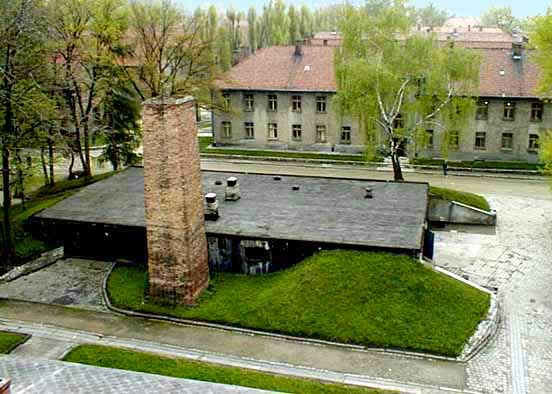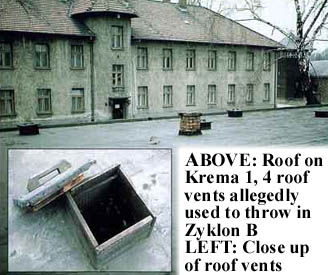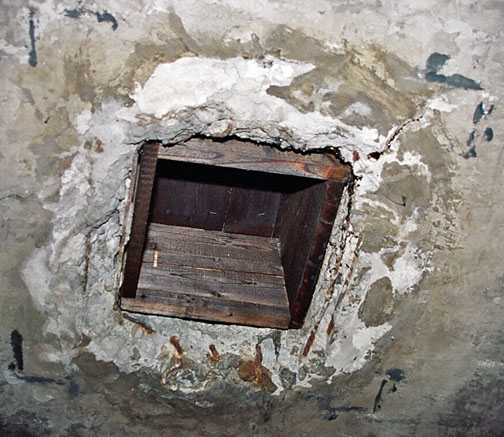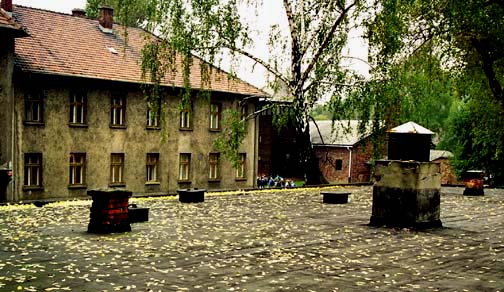[back] Auschwitz-Birkenau

Auschwitz I 'gas chamber'
(Krema I)
[back] Auschwitz-Birkenau
[This so called gas chamber (with
Birkenau 'gas chamber'), is the one that underpins the
Holocaust gas chamber claim as they admit now (after claiming there were, eg
Dachau) there were none in Germany. From
1940 to 1943 it was a morgue,
with a washroom, etc; from June 1944 to January 1945,
it was an air-raid shelter for the SS-hospital with a
surgery room. After the war they knocked some 'Zyklon B input
holes' in the roof, made a door in the SE and called it a 'gas chamber.' (1).
They admit to it being a 'reconstruction.'
Who would place a
cyanide gas
chamber 30 metres from a hospital? See Gas chambers (real).
The
curator, Piper, admitted that the
Russians put the holes in the roof around 1947, hence
their poor quality (and built the crematory chimney), that they packed in 10
people per square yard! To get the required heat to activate Zyklon B they
relied on body heat! It took 20 minutes (while
killing lice took 24 hours), and there was no extraction system, it was
ventilated by convection! Both doors
opened inward! And the door handles could be operated
from the inside! Just like a gas shelter
1,2.
There is no blue
staining from Zyklon B as there is in the
Birkenau delousing buildings.
The main evidence for gassing comes from the Commandant
Rudolf Hoess, but he was tortured into
confessing, then executed (so he couldn't change his story, along with the
other Commandants
Josef Kramer and
Richard Baer.]
See: Gas chambers (real) Gas chambers (large)
Birkenau 'gas chambers' (Krema II-V)
Fake Nazi 'gas chamber' at Sachsenhausen
Articles, interviews
[1993 Robert Faurisson] Letter to Bradley
Smith and David Cole on the gas chamber in Auschwitz - I
[2009] The "gas chamber" of Auschwitz-I by Dr. Robert Faurisson
David Cole Interviews Dr. Franciszek Piper, Director, Auschwitz State Museum
[1996] Interview with Franciszek Piper
[1995] Major French Magazine Acknowledges Auschwitz Gas Chamber Fraud
[1998] The "Gas Chamber" of Auschwitz I by Robert FAURISSON
Documents from the Moscow Archives describe building of air-raid shelters in Auschwitz-Birkenau in 1943 The document, as it stands, clearly supports the gas shelter/bomb shelter interpretation of Morgue 1 of Crematorium II, confirming Dr. Butz' hypothesis, as well as the interpretation of David Irving, Fritjof Meyer, Wilhelm Stäglich, Fritz Berg, Samuel Crowell, and several other revisionists.
Quotes
Museum officials eventually admitted to Felderer that the
entire "gas chamber" at Auschwitz I was rebuilt in various stages to "help"
tourists understand what occurred. (18-4298) Felderer concluded that there
had never been any gas chamber at Auschwitz I and that the building had been
nothing more than a crematory and morgue, later altered in 1943 to an air-raid
shelter with a surgical room. Felderer advised Zündel of his conclusions.
(19-4356) [Ditlieb
Felderer] The 'False News' Trial of Ernst Zündel -- 1988
As Conan knows, already in 1976 I demonstrated the falsehood of this entire
story by questioning Museum official Jan Machalek, and by finding in the
Auschwitz Museum files original plans clearly showing that, in fact, the alleged
"gas chamber" was, between October 7, 1941, and August 31, 1943, a room with a
single entrance where dead bodies awaiting cremation were stored.
If Museum officials now wish to rebuild the room as it was
during the war, they will have to fill in the south-east doorway. After doing
so, though, they would no longer be able to explain how the alleged victims
entered the "gas chamber" for gassing. I do not think the officials would dare
contend that the victims entered by way of the door of the ovens room.
[1995] Major French Magazine Acknowledges Auschwitz Gas
Chamber Fraud
Ken Wilson, a specialist in aerial photographs, had shown that the homicidal "gas chambers" of Auschwitz and Birkenau did not have gas evacuation chimneys, which would have been indispensible. He also showed that I had been right in accusing Serge Klarsfeld and Jean-Claude Pressac of falsifying the map of Birkenau in the Auschwitz Album (Seuil Publishers, 1983, p. 42). Those authors, in order to make the reader believe that groups of Jewish women and children surprised by the photographer between crematories II and III could not go any farther and were thus going to end up in the "gas chambers" and those crematories, had simply eliminated from the map the path which. in reality led up to the "Zentralsauna," a large shower facility (located beyond the zone of the crematories), where those women and children were actually going. The Zündel Trials (1985 and 1988) by ROBERT FAURISSON
In 1945 the Allies should have asked specialists on American gas chambers to examine the buildings, at Auschwitz and elsewhere, which were supposed to have been used to gas millions of people. Since 1977, I have had the following idea: when one deals with a vast historical problem like that of the reality or the legend of the Holocaust, one must strive to get to the core of the problem; In this case the central problem is Auschwitz and the core of that problem is a space of 275 square meters: the 65 square meters of the "gas chamber" of crematorium I at Auschwitz and, at Birkenau, the 210 square meters of the "gas chamber" of crematorium II. In 1988, my idea remained the same: let us have expert studies of those 275 square meters and we will have an answer to the vast problem of the Holocaust! I showed the jury my photos of the gas chamber at the Maryland State Penitentiary in Baltimore as well as my plans for the Auschwitz gas chambers and I underlined the physical and chemical impossibilities of the latter ones. The Zündel Trials (1985 and 1988) by ROBERT FAURISSON
Auschwitz-Birkenau. The few air photos of Auschwitz-Birkenau known to date from the period of December 1943 to February 1945 show no signs of fuel depots, smoke from chimneys or open fires, burning pits or pyres. The photos were altered: Zyklon B input hatches, groups of inmates, and walls around crematoria were retouched onto the photo negatives. Insofar as they still exist, photos of good quality are being kept from the public. One must assume that any actual mass murder activities would not have escaped the notice of the air photo interpreters. This would have resulted in the bombing of the camp - which, however, was carefully refrained from. AIR PHOTO EVIDENCE by JOHN CLIVE BALL
In Holocaust literature, the vents were allegedly used as the openings to
drop in the Zyklon B, which produced the hydrogen cyanide gas after it reached
the floor of the facility. Zyklon B was a special preparation of hydrogen
cyanide gas where the gas was forced by compression into particles of chalk or
wood pulp. These particles carried the gas and would, upon heating or being
exposed to air, release the gas into the area where the gas was to be utilized.
One of the main requirements for driving or evaporating the hydrogen cyanide gas
out of the Zyklon B was excessive temperature. It had to be heated to above 78
or 79 degrees Fahrenheit. If the temperature was not near the 78 degree point,
it would be released much slower and over a much longer period of time. Leuchter
pointed out that of the four vents, one was in the area of a washroom and not in
the presumed gas chamber at all. The alleged gas chamber room was extremely cold
and damp.
The alleged gas chamber area had no exhaust system for
removing the gas. It simply had three vents in the roof. Assuming the area was
used as a gas chamber, it would take the better part of a week to air it out
before any humans could go in to remove anything that was inside the chamber
area. (32-9071)
There were two drains in the area that was alleged to be the
gas chamber. These drains were tied into the main drainage system of the camp.
Leuchter testified that if the area were utilized as a gas chamber, liquid
condensed hydrogen cyanide gas would get into the drains, mix with the water and
eventually wind up coming out every storm drain and possibly every sink drain
and toilet in the camp. The drains made the room a very dangerous place to
utilize as a gas chamber. (32-9068; Photograph of drain on the floor of the
alleged gas chamber at Krema I entered as part of Exhibit 145)
[Fred A. Leuchter]
The 'False News' Trial of Ernst Zündel -- 1988
Leuchter testified that if the mortuary had been used as a gas chamber, there would have been a very high concentration of gas when the pellets were first dropped into the room, as much as 99 to 100 percent concentration. The doorway that led from the mortuary directly into the crematory was not gasketed. The furnaces in the crematory would have been operating at something around 1,500 or 1,600 degrees Fahrenheit. Leuchter stated that anything over 1,100 degrees would cause an explosion if the gas escaped from the gas chamber area into the crematory area. Thus, the juxtaposition of the two facilities in the same building was dangerous. [Fred A. Leuchter] The 'False News' Trial of Ernst Zündel -- 1988
In Leuchter's opinion, if the building had in fact been used as a gas
chamber, it should have been designed and prepared in a manner different than it
was. The entire area that contained the gas should have been coated, both inside
and out, with tar or pitch to prevent any gas leakage. It should have had some
type of exhaust system to bring fresh air in and exhaust the gas present in the
chamber. It did not have such an exhaust system. The exhausted gas would
normally be sent through a 40-foot high chimney or stack and blown into the air
where it was high enough above the surrounding buildings so the gas and air
mixture could be harmlessly scattered. As it was, the vents were less than one
foot high. It would probably have taken a week to air the room and the gas would
have leaked out very close to the top of the roof. Undoubtedly, the gas would
have blown towards buildings in the immediate vicinity of the alleged gas
chamber, including the SS hospital and SS buildings, causing the death of people
in those buildings. (32-9073, 9074)
Leuchter concluded that the alleged gas chamber at Krema I
could not have been used, then or now, as a gassing facility for executing human
beings. (32-9076) The facility would have been much too dangerous to operate
because of gas leakage to the surrounding area and into the crematorium, where
such leakage would have caused an explosion. Personnel operating the facility
probably would have been killed. None of the walls, either inside or out, were
coated in the normal manner. The normal manner prescribed for delousing chambers
by the German military and health officials was tar or pitch painted both inside
and outside. There was no 40- foot stack, so the gas would have come out of the
building very low, and probably would have hovered immediately around the
building. Since the nearest building was the SS hospital, which was higher, this
would have stopped the wind from dissipating the gas. The storm drain connection
to the drains in the floor of the alleged gas chamber would have allowed the gas
out into the main area of the camp. In short, in Leuchter's opinion, the
building would have been very dangerous to use not just for the inmates but for
all camp staff and personnel. (32 9077) [Fred A.
Leuchter]
The 'False News' Trial of Ernst Zündel -- 1988
Since 1985 it is even less possible. In January-March 1985, the trial of Ernst Zündel, who was accused by a Jewish association and by the Crown of spreading Revisionist literature, took place in Toronto (Canada). Rudolf Vrba testified as a Crown witness. (He lives now in British Columbia). Affirmative and self assured as long as he answered the questions of the Crown, he suffered a spectacular rout when cross-examined by Ernst Zündel's lawyer, Doug Christie. For the first time since 1945 a Jewish witness to the alleged gassings in Auschwitz was asked to explain his affirmations and his figures. The result was so terrible for R. Vrba that finally the Crown itself gave a kind of coup de grace to its key witness. That unexpected event and some others (like the leading specialist of the Holocaust, Raul Hilberg, being caught red-handed in his lies) really made of the "Toronto Trial" the "Trial of the Nuremberg Trial." [1986] How the British Obtained the Confessions of Rudolf Höss by Robert Faurisson
One qualitatively excellent sequence of photos from June 26, 1944 breaks off just before Auschwitz. While it is possible that the cameras were turned off immediately after the plane flew over the main point of interest, namely the synthetic rubber plant in Monowitz, it seems more probable that these photos of excellent quality and resolution were in fact removed before the public could view them.AIR PHOTO EVIDENCE by JOHN CLIVE BALL
A map taken from a book by former Auschwitz inmate Maximillian Kobler was, to Felderer's knowledge, the only map of the camp to indicate the theatre as a theatre, and to label the alleged gas chamber, not as a gas chamber, but as a crematory, which, in Felderer's opinion, it actually was. [Ditlieb Felderer] The 'False News' Trial of Ernst Zündel -- 1988
Close-up slides of the aerial photographs indicated that the alleged gas chamber in Auschwitz I was about 30 metres from the SS hospital building. (18-4260) Felderer was told by people in the town of Auschwitz that during the war people could obtain special permission to take tours of the camp on special days. [Ditlieb Felderer] The 'False News' Trial of Ernst Zündel -- 1988
The first door, which had a peephole in it, opened into a small vestibule.
Anyone looking through the peephole did not see into the alleged gas chamber,
but saw only a concrete wall approximately one and a half metres away. (18-4294,
4299) Felderer testified that the peephole had significance in exterminationist
literature because the Nazis were supposed to have watched with great pleasure
as the people died. (18-4295)
The doors to the alleged gas
chamber were not iron or airtight as was also claimed in exterminationist
literature. The doors were made of wood with simple handles and locks. One door
had a pane of thin glass in it. (18-4295, 4296) Both doors opened inward.
Felderer pointed out that the exterminationist literature described people
rushing to the doors in an attempt to escape death, and piling up to the
ceiling. He questioned how the Nazis could have opened the doors after each
gassing when they opened inward - the pile of corpses would have prevented it.
"It was to me not a very ingenious way of building and making a door," said
Felderer. (18-4296, 4297)
Felderer asked Auschwitz Museum
officials why people about to be gassed inside the room never broke the glass in
the door to get out. The usual answer was that no one had ever asked them those
types of questions before. To Felderer, these things indicated that the room was
not one where millions of people were gassed. (18-4296)
[Ditlieb Felderer]
The 'False News' Trial of Ernst Zündel -- 1988
Slides of the vents on the roof of the alleged gas chamber, through which the Zyklon B was allegedly thrown, showed them to be very shoddily made wooden contraptions. (18-4282) Photographs of these four vents from the inside of the alleged gas chamber indicated very rough workmanship; the reinforcement iron bars in the concrete roof were clearly visible in some slides. Felderer testified that this shoddiness flew in the face of exterminationist literature which insisted that these vents were scientifically devised airtight openings. When asked about the vents, Piper later conceded that they were made around 1947. [Ditlieb Felderer] The 'False News' Trial of Ernst Zündel -- 1988
There were no shower heads in the alleged gas chamber at Auschwitz although it was claimed that the gas in most instances entered through shower heads. (18-4287) There were drainage openings, however, which seemed to indicate that two toilets were once located in the room. (18-4289) Infrared film showed that there were once several partitions in the room. (18- 4299, 4300) Felderer received blueprints from the Auschwitz officials which showed how the building looked at different stages. In the beginning, it had actually been a crematory with two furnaces and a morgue. After Birkenau was completed, cremations were carried out at the crematories in that camp while the crematory at Auschwitz I was converted into a hospital shelter in the case of an air raid. Partition walls were put up in the morgue (the alleged gas chamber) to create four small rooms, one of which was a surgery room. (19-4354, 4355) [Ditlieb Felderer] The 'False News' Trial of Ernst Zündel -- 1988
One of Weisenthal's victims who still languishes in prison in West Germany is the attorney, Manfred Roeder. Weisenthal was enraged because Roeder had dared to write the preface to the famous revelations contained in the brochure, "The Auschwitz Lie", by Thies Christopherson. Christopherson had spent the entire war at Rajsko, the ancillary camp at Auschwitz, and therefore could be trusted to know what he was writing about. Weisenthal says, "I don't know what induced Christopherson to dispute that there had been gas chambers at Auschwitz", implying that Christopherson had been bribed to make these statements. The fact that Christopherson was merely reporting his own observations at the scene caused Weisenthal to explain it as "mental derangement", a favorite ploy of the Zionist conspirators, which can always be upheld if a friendly Zionist psychiatrist can be found nearby. Victims By Eustace Mullins

Hospital opposite 'gas chamber'? Absurd.

